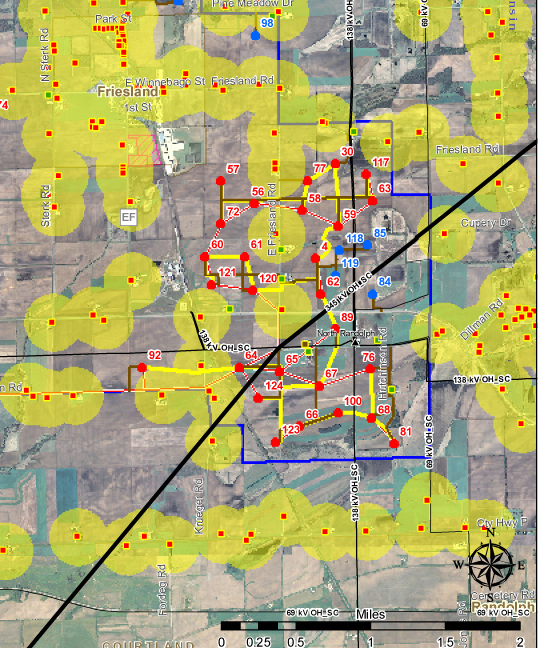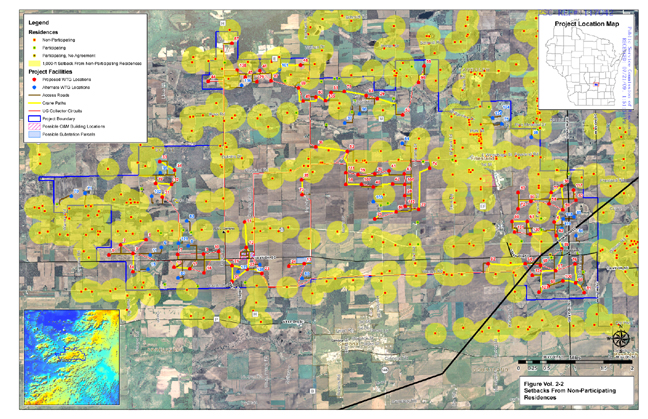Entries in wind turbine wisconsin (3)
3/5/12 RED ALERT: Contact your Wisconsin State legislators today!
 RED ALERT! RED ALERT! CALL TO ACTION!
RED ALERT! RED ALERT! CALL TO ACTION!
One year ago the JCRAR suspended PSC 128- (uniform rules for siting wind projects in the state of Wisconsin)
The JCRAR found that the rules contained in PSC 128 "create an emergency relating to public health, safety, or welfare; are arbitrary and capricious; and impose an undue hardship on landowners and residents adjacent to wind turbine sites".
Senate Bill 50 -- which may come up for a vote on Tuesday, will scrap PSC 128, and task the Public Service Commssion with coming up with rules that protect the health, safety and welfare, and do not cause undue hardship on landowners and residents living in wind projects. In the mean time, more protective local ordinances adopted by many Towns in Wisconsin will stand.
WHAT YOU CAN DO RIGHT NOW TO HELP:
Please make EVERY call and send EVERY email you can. Every person's call and email is counted, and will make a difference.
Call and email the legislators on the list below and ask them to vote in favor of SB 50 (the wind siting bill). If you call after business hours you can still leave a message on their voice mail. You can also send a fax.
You can make a big difference today that will help rural Badgers across the entire state.
CALL, EMAIL AND FAX LIST
Robert Cowles (R) Sen.Cowles@legis.wisconsin.gov Phone:(800) 334-1465 Fax:(608) 267-0304
Alberta Darling (R) Sen.Darling@legis.wisconsin.gov Phone:(608) 266-5830 Fax:(608) 267-0588
Michael Ellis (R) Sen.Ellis@legis.wisconsin.gov Phone:(608) 266-0718 Fax:(608) 267-6798
Scott Fitzgerald (R) Sen.Fitzgerald@legis.wisconsin.gov Phone(608) 266-5660: Fax:(608) 267-6795
Pam Galloway (R) Sen.Galloway@legis.wisconsin.gov Phone:(608) 266-2502 Fax:(608) 267-9027
Glenn Grothman (R) Sen.Grothman@legis.wisconsin.gov Phone:(800) 662-1227 Fax:608) 282-3560
Sheila Harsdorf (R) Sen.Harsdorf@legis.wisconsin.gov Phone:(608) 266-7745 Fax:(608) 267-0369
Neal Kedzie (R) Sen.Kedzie@legis.wisconsin.gov Phone:(608) 266-2635 Fax:(608) 282-3551
Frank Lasee (R) Sen.Lasee@legis.wisconsin.gov Phone:(608) 266-3512 Fax:(608) 267-6792
Mary Lazich (R) Sen.Lazich@legis.wisconsin.gov Phone:(800) 334-1442 Fax:(608) 267-6790
Joe Leibham (R) Sen.Leibham@legis.wisconsin.gov Phone:(888) 295-8750 Fax:(608) 282-3549
Terry Moulton (R) Sen.Moulton@legis.wisconsin.gov Phone:(608) 266-7511 Fax:(608) 282-3563
Luther Olsen (R) Sen.Olsen@legis.wisconsin.gov Phone:(608) 266-0751 Fax:(608) 267-4350
Dale Schultz (R) Sen.Schultz@legis.wisconsin.gov Phone:(800) 978-8008 Fax:(608) 267-0375
Leah Vukmir (R) Sen.Vukmir@legis.wisconsin.gov Phone:(608) 266-2512 Fax:(608) 267-0367
Van Wanggaard (R) Sen.Wanggaard@legis.wisconsin.gov Phone:(866) 615-7510 Fax:(608) 282-3561
Rich Zipperer (R) Sen.Zipperer@legis.wisconsin.gov Phone:(608) 266-9174 Fax:(608) 282-3573
Tim Carpenter (D) Sen.Carpenter@legis.wisconsin.gov Phone:(800) 249-8173 Fax:608) 282-3543
Spencer Coggs (D) Sen.Coggs@legis.wisconsin.gov Phone:(877) 474-2000 Fax:(608) 282-3546
Tim Cullen (D) Sen.Cullen@legis.wisconsin.gov Phone:(800) 334-1468 Fax:(608) 282-3555
Jon Erpenbach (D) Sen.Erpenbach@legis.wisconsin.gov Phone:(888) 549-0027 Fax:(608) 266-2508
Dave Hansen (D) Sen.Hansen@legis.wisconsin.gov Phone:(866) 221-9395 Fax:(608) 267-6791
Jim Holperin (D) Sen.Holperin@legis.wisconsin.gov Phone:(608) 266-2509 Fax:(608) 267-0309
Robert Jauch (D) Sen.Jauch@legis.wisconsin.gov Phone:(800) 469-6562 Fax:(608) 266-3580
Chris Larson (D) Sen.Larson@legis.wisconsin.gov Phone:(608) 266-7505 Fax:(608) 282-3547
Julie Lassa (D) Sen.Lassa@legis.wisconsin.gov Phone:(608) 266-3123 Fax:(608) 282-3564
Mark Miller (D) Sen.Miller@legis.wisconsin.gov Phone:877) 862-4825 Fax:(608) 282-3556
Fred Risser (D) Sen.Risser@legis.wisconsin.gov Phone:(608) 266-1627 Fax:608) 266-1629
Lena Taylor (D) Sen.Taylor@legis.wisconsin.gov Phone:(608) 266-5810 Fax:(608) 282-3544
Kathleen Vinehout (D) Sen.Vinehout@legis.wisconsin.gov Phone:(877) 763-6636 Fax:(608) 267-2871
Robert Wirch (D) Sen.Wirch@legis.wisconsin.gov mailto:Phone:(888) 769-4724 Fax:(608) 267-0984
Jessica King (D) Sen.King@legis.wisconsin.gov Phone:(888) 736-8720 Fax:(608) 282-3558
Jennifer Shilling (D) Sen.Shilling@legis.wisconsin.gov Phone:(608) 266-5490 Fax:(608) 282-3572
2/10/11 What's the latest from the Capitol? What happened at the hearing on the PSC's wind siting rules? AND Big Wind VS Little Birds. Guess who wins? Want to do something about it?
Click on the image above to see what an industrial wind project looks like after the sun goes down. People are often surprised to find out that all of the lights blink in unison. Why? These are FAA lights and red lights blinking in unison are the best way to get a pilot's attention. Red lights in the entire wind project area, which is sometimes thousands of acres, flash on and off all night long to keep aircraft from colliding with turbine blades.
Click on the image above to hear noise from the closest turbine to the home of Larry Wunsch who lives in the Invenergy wind project near the Town of Byron in Fond du Lac County.
This noise is the reason the Wunsch family decided to sell their home. However, after two years they've had no offers. Wunsch says that buyers who come to see the house don't even make it up the driveway. They turn around once they see the turbines surrounding his home.
This video was recorded from the front door of the Wunsch home with a video camera microphone not suited for noise such as this, nevertheless, the pulsing character of wind turbine noise is clear.
Larry Wunsch is a fire fighter and served on the Wind Siting Council. He testified at the Capitol yesterday, asking for a suspension of the PSC wind siting rules because they are not protective enough. Wunsch testified that while on the Wind Siting Council, he wanted to play his recording of turbine noise to help council members understand the problem but he was not allowed to do so.
Below, video of shadow flicker in another Fond du Lac county home at 6:30 AM
Above, shadow flicker in homes located in the Invenergy Forward Energy project, filmed by resident Gerry Meyer who also testified at the Capitol hearing.
WIND SITING RULES GET CAPITOL HEARING
Source: Wisconsin Radio Network
February 10, 2010
By Bob Hague
Lawmakers weighed the balance of wind energy in Wisconsin at the Capitol on Wednesday, with developers of wind turbine farms pitted against property owners and local governments who argue the massive turbines decrease property values and cause health problems.
Governor Scott Walker had proposed a special session bill which would have increased the setback for wind turbines from 1250 feet from a property line, to 1850 feet. That bill failed to advance, so now the Joint Committee on Administrative Rules is taking second look at the Public Service Commission rules which are scheduled to go into effect next month.
As the day long hearing got underway, committee members commented on the lengthy process of public hearings held by the PSC as the rules were being developed.
“I know it was a difficult task,” said Representative Dan Meyer (R-Eagle River). “But I have a feeling a lot of these people feel this is just going to be rammed down their throat. They may not want windmills in their backyard, but there going to get them, because the state of Wisconsin says ‘you’re going to have them.’”
State Senator Lena Tayler (D-Milwaukee) responded to Meyer’s comment. “There isn’t ramming going on here . . . 2009 to now is not ramming.”
Larry Wunsch is a landowner near Brownsville in south Fond du Lac county. Wunsch told the Joint Committee on Administrative Rules that a wind
farm near his property – and a turbine 1250 feet from his home – have changed his life. “When you put a device so close to my land that it drives me out of my property, I do have a say on that,” Wunsch told committee members. “We should be protecting Wisconsinites here.
Wunsch, who served on the Public Service Commission’s Wind Siting Council and signed onto its Minority Report, said he’s been unable to sell his property. Wunsch testified against the rules with another member of the Wind Siting Council who signed the Minority Report, Doug Zweizig from the Town of Union in Rock County. “The rules as written will not protect the health safety and welfare of impacted Wisconsin residents and communities,” said Zweizig, who serves on the Union Town Board, which had written its own ordinance on wind siting. Those impacts include sleep deprivation for a significant percentage of people living near turbines, according to Green Bay physician, Dr. Herb Cousins. “We make outstanding guidelines and rules for peanut allergies in school, when less than one percent or so of the population is affected by that,” Cousins said. “In this circumstance, up to fifty percent or more at this 1200 foot range will be affected.”
But Jeff Anthony with the American Wind Energy Association said if lawmakers decide to suspend the PSC rules, they’ll throw wind development projects around the state into chaos – and cost Wisconsin jobs. “The $1.8 million of investment in future wind projects that are currently on the books and planned for Wisconsin, will not happen. Two million construction job hours to build those projects, will not happen in this state,” said Anthony. “Farther down the road, you could have an impact on the manufacturing sector.”
The rules were drafted as a response to an uncertain landscape for wind development in Wisconsin, as local governments such as Doug Zweizig’s town board drafted their own – sometimes restrictive – wind siting ordinances. But Bob Welch, a former state lawmaker who now lobbies on behalf of a coalition of opponents, said the PSC rules go too far. “What the PSC rules want to do is say ‘you don’t get to decide what goes in your community. You have nothing, absolutely nothing to say about it’ if these rules are in place. They’re going to decide what goes in your community, not you. I don’t think that’s the Wisconsin way.”
Landowners who have wind turbines sited within a half mile of their property lines are eligible for ‘good neighbor’ payments. But apparently not all are interested in getting the money. “I have two of them within that parameter, so I would make a thousand dollars a year,” Larry Wunsch told the committee. “Personally I think it’s dirty money, it’s bribe money and I’ve never taken it, I don’t plan to take it. If they want to make it right with me, buy my house. Let me get out of there.”
AUDIO: Larry Wunsch, Doug Zweizig (7:00)
PSCs Final Wind Siting Council Report (PDF)
Click on the images below to watch short videos of the Wind Siting Council in action
WISCONSIN RULE ON TURBINE BUFFERS HIT CLOSE TO HOME FOR SOME
February 10, 2011
By Andrew Averill
A legislative joint committee heard over nine hours of passionate testimony Wednesday from several hundred citizens and wind energy developers on a rule that would standardize the buffer distance between a wind turbine and surrounding structures across the state.
The Joint Committee for Review of Administrative Rules heard testimony on a wind siting rule proposed by the Public Services Commission. The rule specifies the restrictions a city, village, town or county could impose on wind energy systems. While wind developers mainly agreed with the PSC, a large portion of citizen testifiers opposed the rules, Sen. Fred Risser, D-Madison, said.
“The majority of [testifiers] I’d say were people who didn’t want the rules,” Risser said. “When you get down to it, they didn’t want windmills.”
The rule would require turbine setback distances for non-participatory properties to equal three times the maximum length of the turbine blade. Turbines only have to be one blade length away from the property hosting it.
Most citizens testified the distances are not far enough away and have caused unwanted effects.
Joan Lagerman from Malone, located on the east side of Lake Winnebago, told the committee she had stories that realized the fears other testifiers brought up. Her son, an otherwise healthy 17-year-old, recorded systolic blood pressure as high as 160, which she attributes to the turbine near her house, she said.
Another man with three turbines near his property recalled coming home to take care of his wife who was sick with the flu. He returned at night expecting his wife to be resting in bed, but saw her writhing on the floor in the middle of the hallway squeezing blankets and pillows against her ears trying to dampen the sound from the turbines.
Other opponents of the rule spoke of developer’s “time-share hustling” property owners with 28-page contracts, persistent radio interference, deteriorating health of farm animals due to stray voltage and constant low frequency humming.
Hearing loss can occur with noise levels over 85 decibels, according to a National Institute for Occupational Safety and Health study. The PSC rule requires turbines to be no louder than 50 db, but one citizen in Fond du Lac County said he measured the turbine at a constant 63 db.
However direct the citizen testimony, Risser said the question the committee must ask in deciding whether to uphold, modify or suspend the PSC’s rule is what is best for the state, and there are people who feel very strongly the state should pursue wind energy and the jobs it would provide Wisconsin.
Chris Deschane, speaking on behalf of wind developer Michels Corporation located an hour northeast of Madison in Fond du Lac, said he supported the PSC rule and elaborated on the jobs that Michels could create if the committee voted in favor of the rule.
“For each 100 megawatts in Wisconsin, it will generate 125 immediate jobs that last for one or two years and several dozen recurring jobs,” Deschane said. “Each of these jobs are well compensated and we provide exceptional health benefits.”
Another developer, David Vander Leest of Prelude LLC Wind Farms, said if the rule is not passed and the setback distance between a wind turbine and the nearest structure is increased as a result, Wisconsin might as well give the wind industry of “time of death.”
Although Risser said both developers and citizens gave strong arguments, he suspects the committee would vote to suspend the rule sometime before March 1, when the rule would begin to take effect.
BIRD DEATHS FROM WIND FARMS TO CONTINUE UNDER NEW FEDERAL VOLUNTARY INDUSTRY GUIDELINES
SOURCE: American Bird Conservancy
February 10, 2011
(Washington, D.C.) Draft voluntary federal guidelines issued today by the Interior Department that focus on the wildlife impacts of wind energy will result in continued increases in bird deaths and habitat loss from wind farms across the country, says American Bird Conservancy (ABC), the nation’s leading bird conservation organization. Members of the public will have 90 days to provide comments on the proposed guidelines to the Secretary of the Interior prior to a final version being concluded.
“We had hoped that at the end of this multi-year, Interior Department process, we would see mandatory regulations that would provide a reasonable measure of restraint and control on a potentially very green energy source, but instead we get voluntary guidelines,” said ABC Vice-President Mike Parr.
“Bird deaths from wind power are the new inconvenient truth. The total number of birds killed and the amount of bird habitat lost will dramatically increase as wind power build-out continues across the country in a rush to meet federal renewable energy targets,” Parr said.
“We fast-tracked dams in the first half of the last century at the expense of America’s rivers. Now we’re having to tear many of them down. Let’s not fast track wind energy at the expense of America’s birds. Just a few small changes need to be made to make wind bird-smart, but without these, wind power simply can’t be considered a green technology” Parr said.
“This action did not have to result in voluntary guidelines. DOI has the authority under the Migratory Bird Treaty Act to enact regulations protecting migratory birds. Further, it is troubling that this announcement was made without the final documents being available that would enable a review of exactly what is being proposed,” Parr said.
Some of the most iconic and vulnerable American birds are at risk from wind industry expansion unless this expansion is carefully planned and implemented. Onshore, these include Golden Eagles, Whooping Cranes, sage-grouse, prairie-chickens, and many migratory songbirds. Offshore, Brown Pelicans, Northern Gannets, sea ducks, loons, and terns are among the birds at risk.
“Federal government estimates indicate that 22,000 wind turbines in operation in 2009 were killing 440,000 birds per year. We are very concerned that with Federal plans to produce 20 percent of the nation’s electricity from wind by 2030, those numbers will mushroom. To meet the 2030 goal, the nation will need to produce about 12 times more wind energy than in 2009.” he added.
“The guidelines ask the wind industry to do the right things, but there is no reason to believe that any will happen with any consistency. The poster child for the wind industry’s environmental track record is the Altamont Pass Wind Farm in California. Despite years of concern voiced by many in the wildlife community about large numbers of eagles and other raptors being killed at Altamont, it took a lawsuit to get the industry to respond,” Parr said.
“Birds continue to be killed at Altamont and other wind farms in violation of the Migratory Bird Treaty Act,” he added.
American Bird Conservancy supports wind power when it is bird-smart, and believes that birds and wind power can co-exist if the industry is held to mandatory standards that protect birds. ABC has established a petition for concerned members of the public to lend their support to the campaign for bird-smart wind.
Onshore bird-smart wind power implements siting considerations, operational and construction mitigation, bird monitoring, and compensation, to redress unavoidable bird mortality and habitat loss. Although offshore wind power is not yet operational in the U.S., an analogous set of siting, operating, and compensatory measures needs to be developed to make it bird-smart.
All wind farms should have an Avian Protection Plan that includes ABC’s bird-smart principles and a means of implementing it and tracking and reporting on its implementation. Wind farms should also comply with relevant state and federal wildlife protection laws such as the Endangered Species Act, Migratory Bird Treaty Act, Bald and Golden Eagle Protection Act, and National Environmental Policy Act.
NOTE: American Bird Conservancy conserves native birds and their habitats throughout the Americas by safeguarding the rarest species, protecting and restoring habitats, and reducing threats while building capacity of the bird conservation movement. For moreinformation, visit, www.abcbirds.org
2/1/11 Walker's wind siting bill: What's the big deal? AND Contact your legislators AND Today's Extra Credit Reading List
Wisconsin Home in a Wind Project: Fond du Lac County
WISCONSIN GOVERNOR'S APPROACH TO WIND: BACK OFF A BIT
Source: Renewable Energy World
February 1, 2010
By Jim Cummings, Acoustic Ecology Institute.
When Scott Walker was inaugurated as Wisconsin’s new Governor earlier this month, his first order of business was fully in keeping with his Republican priorities: he called a special session of the state legislature, dubbed the “Wisconsin in Open for Business” session. All bills will be focused on improving the state’s business climate, which in these tough economic times has widespread support.
As part of his job-creation agenda, he submitted a regulatory reform bill, which came with a wild card tucked inside: a new and stricter setback standard for industrial wind farms. While some in the state have attacked the stricter standard as a job-killer, it appears to me that the Governor has his pulse on one of the key avenues that the wind industry should be pursuing in order to gain widespread acceptance in the years to come: strong protections for the private property rights of wind farm neighbors, combined with provisions for mutually agreeable closer siting.
In response to tough local rules that were seen as anti-wind, in 2009 the Wisconsin legislature called for statewide regulations that localities cannot exceed; the state’s PSC recently adopted a new statewide standard of 1250 feet from homes. Governor Walker’s bill would increase setbacks statewide to 1800 feet from property lines.
While this would not protect neighbors from hearing wind turbines, which are often audible at a half mile and can be heard to a mile or more in some situations (some activists and acousticians suggest setbacks in these larger ranges), Walker’s proposal is a substantial increase, and a reasonable middle ground. This sort of approach could well be the clearest path forward for an industry that has been beset by community resistance in recent years, with Wisconsin being one of the most active centers of concern about the effects of wind farm noise.
Critics immediately slammed the change, claiming that it would basically preclude new wind farms in the state. These critiques ignore a key provision of the Governor’s proposal: neighbors closer than 1800 feet can agree to let turbines go up, presumably in exchange for some compensation from the wind company.
It appears that Governor Walker understands that the way to move the wind industry forward is regulations that help local communities to feel more comfortable with the likely impacts of new wind farms, rather than standards designed primarily to ease the placement of turbines. Like it or not, there is increasing concern about noise levels once considered moderate, e.g., 45dB.
Communities nationwide are coming to grips with the fact that wind farms come with some audible noise issues; pushing siting standards too close to homes will only continue to feed the growing stream of “horror stories” that multiply and magnify the problem into ever more communities where wind farms are proposed.
Adopting setbacks that truly do protect the most noise-sensitive community members, while allowing turbines to go up closer to folks who have no problem with them, could well be the smoothest, and fastest, way forward. Governor Walker’s combination of larger setbacks, and provisions for neighbors to sign waivers, is the right direction for growing this industry without threatening the quality of life of rural communities.
See AEINews for ongoing coverage of wind noise issues.
WHAT'S AT ISSUE WITH GOVERNOR WALKER'S WIND SITING BILL:

Pictured Above: Setbacks between 400 foot tall wind turbines and homes in a PSC-approved wind project Fond du Lac County Wisconsin. The yellow circles indicate the 1000 foot safety zone around each turbine.
Pictured Below: PSC approved Glacier Hills Wind Project under constrution in Columbia County. In this map from WeEnergies, red dots are turbine locations. Each yellow circle containing a small red square is a non-participating home.
When they permitted the wind project, the PSC admitted that there were too many turbines around some homes but instead of asking for fewer turbines in those areas they asked the wind company to offer to purchase the homes. They did.



The PSC wind rules allow safety zones to cross property lines and allow a wind company to automatically use a neighbor's land as part of that safety zone. This creates a no-build and no tree planting zone on the property of a non-particpating land owner who must to get permission from the wind company to build a structure or plant a tree on his own land.
Senate Bill 9 helps to correct this problem.
The PSC statewide siting rules are to take effect on March 1st, 2011. They have setbacks of 1250 feet between homes and a 500 foot turbine. The rules allow a wind company to use a non participating landowner's property as a safety setback zone.
Senate Bill 9 increases the setback to 1800 feet between turbines and property lines. If a landowner wants a turbine closer he can enter into an agreement with the wind company. This bill gives some choice and a little more protection to the rural Wisconsin families who have no choice about living beneath the turbines.

PICTURED ABOVE: a map showing the noise level predicted for residents in Invenergy's proposed Ledge Wind Project in Brown County. The yellow dots are homes. The black dots are wind turbine locations. The World Health Organization says nighttime noise should no louder than 35 dbA for healthful sleep. The deep blue areas indicate predicted turbine noise levels above 50 dbA. The purple areas indicate turbine noise levels of 50dbA.
EXTRA CREDIT READING LIST
THE DIRTY COST OF CLEAN WIND
CLICK HERE to read the whole story
"This is the deadly and sinister side of the massively profitable rare-earths industry that the ‘green’ companies profiting from the demand for wind turbines would prefer you knew nothing about."
